- Click Start, then select Control Panel.
- Click Classic View in the left panel.
- Double-click the Printers icon:

- Windows 7: Click Start, then select Devices and Printers.
- Click Add Printer (see Figure 1).

Figure 1.
- Select Add a network, wireless, or Bluetooth printer, then click Next (see Figure 2).

Figure 2.
- Select The printer that I want isn't listed, then click Next (see Figure 3).
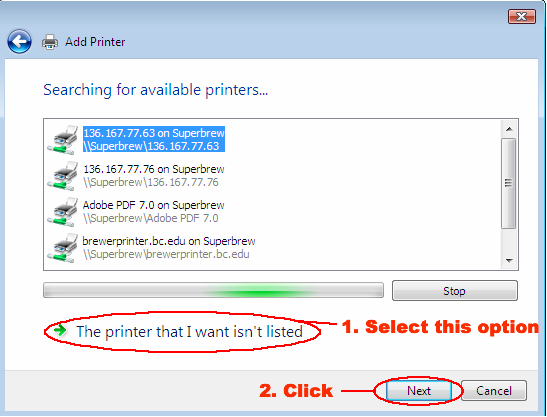
Figure 3.
- Select Add a printer using a TCP/IP address or hostname, then click Next (see Figure 4).
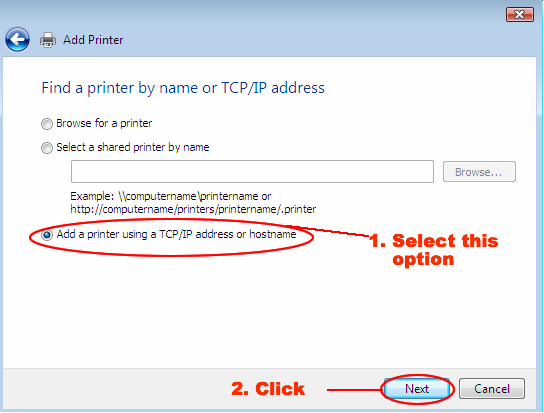
Figure 4.
- In the Hostname or IP address box, enter the printer name followed by ".bc.edu", then click Next (see Figure 5).

Figure 5.
- Select the type of printer you are using, then click Next (see Figure 6).
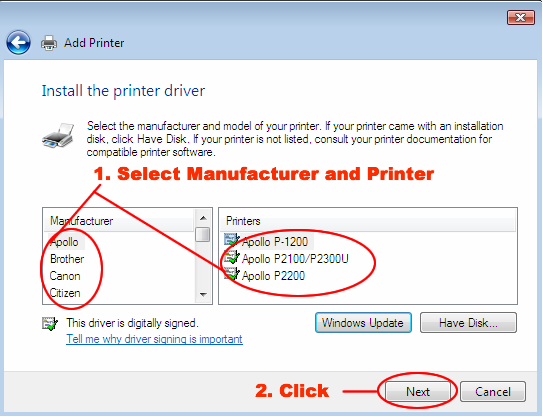
Figure 6.
- On the "Type a printer name window," do the following (see Figure 7):
- In the Printer name box, enter a name for your printer so you can identify it.
- If you want to make this printer your default printer, check Set as the default printer.
- Click Next.
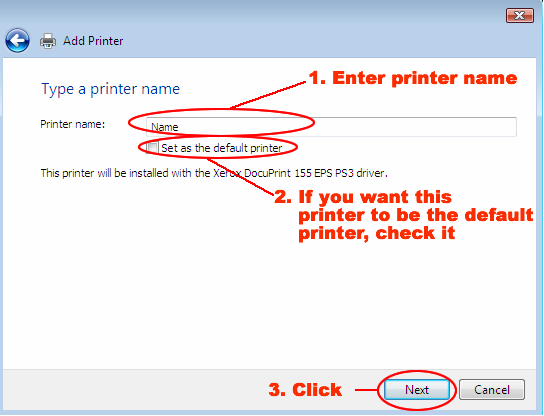
Figure 7.
- On the "You've successfully added" window, do the following (see Figure 8):
- Click Print a test page.
Note: If the test page did not print correctly, call your TC (bc.edu/tc). - When you have successfully printed a test page, click Finish.
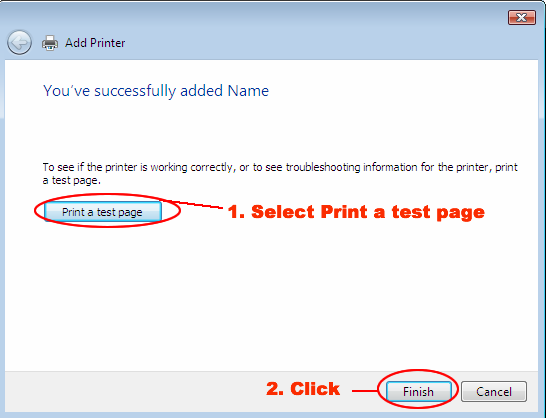
- Click Print a test page.
Monday, January 28, 2013
Adding a Printer from the BC Network
To add a printer from the BC network using Windows Vista (Windows 7 skip to step 4):
Wednesday, January 16, 2013
Windows 8
Windows 8 is the current release of the Windows operating system, produced by Microsoft for use on personal computers, including home and business desktops, laptops, tablets, and home theater PCs. Development of Windows 8 started before the release of its predecessor, Windows 7, in 2009. Its existence was first announced at CES 2011, and followed by the release of three pre-release versions from September 2011 to May 2012. The operating system was released to manufacturing on August 1, 2012, and was released for general availability on October 26, 2012.
Windows 8 introduces significant changes to the operating system's platform, primarily focused towards improving its user experience on mobile devices such as tablets to rival other mobile operating systems like Android and Apple's iOS.Windows 8 introduces a new touch-friendly shell and user interface based on Microsoft's "Metro" design language, featuring a new Start screen with a grid of dynamically updating tiles that represent applications. The Start screen replaces the "Start menu" of earlier Windows versions. There is a new app platform with an emphasis on touchscreen input, and the new Windows Store to obtain and/or purchase applications to run on the operating system.
In addition, Windows 8 takes advantage of new or emerging technologies like USB 3.0, 4Kn Advanced Format, near field communications, cloud computing, and the low-power ARM architecture. It includes new security features such as malware filtering, built-in antivirus capabilities, a new installation process optimized for digital distribution, and support for secure boot (a UEFI feature which allows operating systems to be digitally signed to prevent malware from altering the boot process). Synchronization of certain apps and settings between multiple devices is supported.
Windows 8 was released to mixed reception. Although reaction towards its performance improvements, security enhancements, and improved support for touchscreen devices was positive, the new user interface of the operating system has been widely criticized for being confusing and having a steep learning curve (especially when used with a keyboard and mouse instead of a touchscreen). Despite these shortcomings, 60 million Windows 8 licenses have been sold through January 2013, This includes upgrades and sell in to OEMs for new PCs.
Windows Explorer, which has been renamed File Explorer, now includes a ribbon in place of the command bar. File operation dialog boxes have been updated to provide more detailed statistics, the ability to pause file transfers, and improvements in the ability to manage conflicts when copying files. A new "File History" function allows incremental revisions of files to be backed up to and restored from a secondary storage device, while Storage Spaces allows users to combine different sized hard disks into virtual drives and specify mirroring, parity, or no redundancy on a folder-by-folder basis.
Task Manager has also been redesigned, including a new processes tab with the option to display fewer or more details of running applications and background processes, a heat map using different colors indicating the level of resource usage, network and disk counters, grouping by process type (e.g. applications, background processes and Windows processes), friendly names for processes and a new option which allows users to search the web to find information about obscure processes. Additionally, the Blue Screen of Death has been updated with a simpler and modern design with less technical information displayed.
Windows 8 introduces significant changes to the operating system's platform, primarily focused towards improving its user experience on mobile devices such as tablets to rival other mobile operating systems like Android and Apple's iOS.Windows 8 introduces a new touch-friendly shell and user interface based on Microsoft's "Metro" design language, featuring a new Start screen with a grid of dynamically updating tiles that represent applications. The Start screen replaces the "Start menu" of earlier Windows versions. There is a new app platform with an emphasis on touchscreen input, and the new Windows Store to obtain and/or purchase applications to run on the operating system.
In addition, Windows 8 takes advantage of new or emerging technologies like USB 3.0, 4Kn Advanced Format, near field communications, cloud computing, and the low-power ARM architecture. It includes new security features such as malware filtering, built-in antivirus capabilities, a new installation process optimized for digital distribution, and support for secure boot (a UEFI feature which allows operating systems to be digitally signed to prevent malware from altering the boot process). Synchronization of certain apps and settings between multiple devices is supported.
Windows 8 was released to mixed reception. Although reaction towards its performance improvements, security enhancements, and improved support for touchscreen devices was positive, the new user interface of the operating system has been widely criticized for being confusing and having a steep learning curve (especially when used with a keyboard and mouse instead of a touchscreen). Despite these shortcomings, 60 million Windows 8 licenses have been sold through January 2013, This includes upgrades and sell in to OEMs for new PCs.
New and changed features
Main article: Features new to Windows 8
New features and functionality in Windows 8 include a faster startup through UEFI integration and the new "Hybrid Boot" mode (which hibernates the Windows kernel on shutdown to speed up the subsequent boot), a new lock screen with a clock and notifications, and the ability for enterprise users to create live USB versions of Windows (known as Windows To Go). Windows 8 also adds native support for USB 3.0 devices, which allow for faster data transfers and improved power management with compatible devices, and 4Kn Advanced Format support, as well as support for near field communication to facilitate sharing and communication between devices.Windows Explorer, which has been renamed File Explorer, now includes a ribbon in place of the command bar. File operation dialog boxes have been updated to provide more detailed statistics, the ability to pause file transfers, and improvements in the ability to manage conflicts when copying files. A new "File History" function allows incremental revisions of files to be backed up to and restored from a secondary storage device, while Storage Spaces allows users to combine different sized hard disks into virtual drives and specify mirroring, parity, or no redundancy on a folder-by-folder basis.
Task Manager has also been redesigned, including a new processes tab with the option to display fewer or more details of running applications and background processes, a heat map using different colors indicating the level of resource usage, network and disk counters, grouping by process type (e.g. applications, background processes and Windows processes), friendly names for processes and a new option which allows users to search the web to find information about obscure processes. Additionally, the Blue Screen of Death has been updated with a simpler and modern design with less technical information displayed.
Safety and security
Additional security features in Windows 8 include two new authentication methods tailored towards touchscreens (PINs and picture passwords), the addition of antivirus capabilities to Windows Defender (bringing it in parity with Microsoft's Security Essentials software) SmartScreen filtering integrated into the desktop, and support for the "Secure Boot" functionality on UEFI systems to protect against malware infecting the boot process. Parental controls are offered through the integrated Family Safety software, which allows parents to monitor and control their children's activities on a device with activity reports and safety controls. Windows 8 also provides integrated system recovery through the new "Refresh" and "Reset" functions. Windows 8's first security patches would be released on November 13, 2012; it would contain three critical (most severe as per Microsoft) fixes.Hardware requirements
PCs
The minimum system requirements for Windows 8 are slightly higher than those of Windows 7. Notably, Windows 8 now requires that a system's CPU support certain hardware features, specifically the PAE, NX bit, and SSE2. Windows Store apps require a screen resolution of 1024×768 or higher to run, while a screen resolution of 1366×768 or higher is required to use the snapping functionality for apps.| Criteria | Minimum | Recommended | ||
|---|---|---|---|---|
| Processor | 1 GHz clock rate IA-32 or x64 architecture Support for PAE, NX and SSE2 |
x64 architecture Second Level Address Translation (SLAT) support |
||
| Memory (RAM) | IA-32 edition: 1 GB x64 edition: 2 GB |
4 GB | ||
| Graphics Card | DirectX 9 graphics device WDDM 1.0 or higher driver |
DirectX 10 graphics device | ||
| Display screen | 1024×768 pixels | 1366×768 pixels | ||
| Input device | Keyboard and mouse | A multi-touch display screen | ||
| Hard disk space | IA-32 edition: 16 GB x64 edition: 20 GB |
|||
| Other | USB 3.0 port UEFI v2.3.1 Errata B with Microsoft Windows Certification Authority in its database Trusted Platform Module (TPM) Internet connectivity |
Tablets and convertibles
Microsoft released minimum hardware requirements for new tablet and convertible devices designed for Windows 8, and defined a convertible form factor as a standalone device that combines the PC, display and rechargeable power source with a mechanically attached keyboard and pointing device in a single chassis. A convertible can be transformed into a tablet where the attached input devices are hidden or removed leaving the display as the only input mechanism.| Graphics Card | DirectX 10 graphics device with WDDM 1.2 or higher driver |
|---|---|
| Storage | 10 GB free space, after the out-of-box experience completes |
| Standard buttons | 'Power', 'Rotation lock', 'Windows Key', 'Volume-up', 'Volume-down' |
| Screen | Touch screen supporting a minimum of 5-point digitizers and resolution of at least 1366x768. The physical dimensions of the display panel must match the aspect ratio of the native resolution. The native resolution of the panel can be greater than 1366 (horizontally) and 768 (vertically). Minimum native color depth is 32-bits. |
| Camera | Minimum 720p |
| Ambient light sensor | 1–30k lux capable with dynamic range of 5–60k |
| Accelerometer | 3 axes with data rates at or above 50 Hz |
| USB 2.0 | At least one controller and exposed port. |
| Connect | Wi-Fi and Bluetooth 4.0 + LE (low energy) |
| Other | Speaker, microphone, magnetometer and gyroscope. If a mobile broadband device is integrated into a tablet or convertible system, then an assisted GPS radio is required. Devices supporting near field communication need to have visual marks to help users locate and use the proximity technology. The new button combination for Ctrl + Alt + Del is Windows Key + Power. |
New computer virus list
OPRAH WINFREY VIRUS: Your 200MB hard drive suddenly shrinks to 80MB, and
then slowly expands back to 200MB.
AT&T VIRUS: Every three minutes it tells you what great service you are getting.
MCI VIRUS: Every three minutes it reminds you that you're paying too much for the AT&T virus.
PAUL REVERE VIRUS: This revolutionary virus does not horse around. It warns you of impending hard disk attack---once if by LAN, twice if by C:>.
POLITICALLY CORRECT VIRUS: Never calls itself a "virus", but instead refers to itself as an "electronic microorganism."
RIGHT TO LIFE VIRUS: Won't allow you to delete a file, regardless of how old it is. If you attempt to erase a file, it requires you to first see a counselor about possible alternatives.
ROSS PEROT VIRUS: Activates every component in your system, just before the whole darn thing quits.
MARIO CUOMO VIRUS: It would be a great virus, but it refuses to run.
TED TURNER VIRUS: Colorizes your monochrome monitor.
ARNOLD SCHWARZENEGGER VIRUS: Terminates and stays resident. It'll be back.
DAN QUAYLE VIRUS #2: Their is sumthing rong wit your komputer, ewe jsut cant figyour out watt!
GOVERNMENT ECONOMIST VIRUS: Nothing works, but all your diagnostic software says everything is fine.
NEW WORLD ORDER VIRUS: Probably harmless, but it makes a lot of people really mad just thinking about it.
FEDERAL BUREAUCRAT VIRUS: Divides your hard disk into hundreds of little units, each of which does practically nothing, but all of which claim to be the most important part of your computer.
GALLUP VIRUS: Sixty percent of the PCs infected will lose 38 percent of their data 14 percent of the time. (plus or minus a 3.5 percent margin of error.)
TERRY RANDALL VIRUS: Prints "Oh no you don't" whenever you choose "Abort" from the "Abort" "Retry" "Fail" message.
TEXAS VIRUS: Makes sure that it's bigger than any other file.
ADAM AND EVE VIRUS: Takes a couple of bytes out of your Apple.
CONGRESSIONAL VIRUS: The computer locks up, screen splits erratically with a message appearing on each half blaming the other side for the problem.
AIRLINE VIRUS: You're in Dallas, but your data is in Singapore.
FREUDIAN VIRUS: Your computer becomes obsessed with marrying its own motherboard.
PBS VIRUS: Your programs stop every few minutes to ask for money.
ELVIS VIRUS: Your computer gets fat, slow and lazy, then self destructs; only to resurface at shopping malls and service stations across rural America.
OLLIE NORTH VIRUS: Causes your printer to become a paper shredder.
NIKE VIRUS: Just does it.
SEARS VIRUS: Your data won't appear unless you buy new cables, power supply and a set of shocks.
JIMMY HOFFA VIRUS: Your programs can never be found again.
CONGRESSIONAL VIRUS #2: Runs every program on the hard drive simultaneously, but doesn't allow the user to accomplish anything.
KEVORKIAN VIRUS: Helps your computer shut down as an act of mercy.
IMELDA MARCOS VIRUS: Sings you a song (slightly off key) on boot up, then subtracts money from your Quicken account and spends it all on expensive shoes it purchases through Prodigy.
STAR TREK VIRUS: Invades your system in places where no virus has gone before.
HEALTH CARE VIRUS: Tests your system for a day, finds nothing wrong, and sends you a bill for $4,500.
GEORGE BUSH VIRUS: It starts by boldly stating, "Read my docs....No new files!" on the screen. It proceeds to fill up all the free space on your hard drive with new files, then blames it on the Congressional Virus.
CLEVELAND INDIANS VIRUS: Makes your 486/50 machine perform like a 286/AT.
LAPD VIRUS: It claims it feels threatened by the other files on your PC and erases them in "self defense".
CHICAGO CUBS VIRUS: Your PC makes frequent mistakes and comes in last in the reviews, but you still love it.
ORAL ROBERTS VIRUS: Claims that if you don't send it a million dollars, it's programmer will take it back.
AT&T VIRUS: Every three minutes it tells you what great service you are getting.
MCI VIRUS: Every three minutes it reminds you that you're paying too much for the AT&T virus.
PAUL REVERE VIRUS: This revolutionary virus does not horse around. It warns you of impending hard disk attack---once if by LAN, twice if by C:>.
POLITICALLY CORRECT VIRUS: Never calls itself a "virus", but instead refers to itself as an "electronic microorganism."
RIGHT TO LIFE VIRUS: Won't allow you to delete a file, regardless of how old it is. If you attempt to erase a file, it requires you to first see a counselor about possible alternatives.
ROSS PEROT VIRUS: Activates every component in your system, just before the whole darn thing quits.
MARIO CUOMO VIRUS: It would be a great virus, but it refuses to run.
TED TURNER VIRUS: Colorizes your monochrome monitor.
ARNOLD SCHWARZENEGGER VIRUS: Terminates and stays resident. It'll be back.
DAN QUAYLE VIRUS #2: Their is sumthing rong wit your komputer, ewe jsut cant figyour out watt!
GOVERNMENT ECONOMIST VIRUS: Nothing works, but all your diagnostic software says everything is fine.
NEW WORLD ORDER VIRUS: Probably harmless, but it makes a lot of people really mad just thinking about it.
FEDERAL BUREAUCRAT VIRUS: Divides your hard disk into hundreds of little units, each of which does practically nothing, but all of which claim to be the most important part of your computer.
GALLUP VIRUS: Sixty percent of the PCs infected will lose 38 percent of their data 14 percent of the time. (plus or minus a 3.5 percent margin of error.)
TERRY RANDALL VIRUS: Prints "Oh no you don't" whenever you choose "Abort" from the "Abort" "Retry" "Fail" message.
TEXAS VIRUS: Makes sure that it's bigger than any other file.
ADAM AND EVE VIRUS: Takes a couple of bytes out of your Apple.
CONGRESSIONAL VIRUS: The computer locks up, screen splits erratically with a message appearing on each half blaming the other side for the problem.
AIRLINE VIRUS: You're in Dallas, but your data is in Singapore.
FREUDIAN VIRUS: Your computer becomes obsessed with marrying its own motherboard.
PBS VIRUS: Your programs stop every few minutes to ask for money.
ELVIS VIRUS: Your computer gets fat, slow and lazy, then self destructs; only to resurface at shopping malls and service stations across rural America.
OLLIE NORTH VIRUS: Causes your printer to become a paper shredder.
NIKE VIRUS: Just does it.
SEARS VIRUS: Your data won't appear unless you buy new cables, power supply and a set of shocks.
JIMMY HOFFA VIRUS: Your programs can never be found again.
CONGRESSIONAL VIRUS #2: Runs every program on the hard drive simultaneously, but doesn't allow the user to accomplish anything.
KEVORKIAN VIRUS: Helps your computer shut down as an act of mercy.
IMELDA MARCOS VIRUS: Sings you a song (slightly off key) on boot up, then subtracts money from your Quicken account and spends it all on expensive shoes it purchases through Prodigy.
STAR TREK VIRUS: Invades your system in places where no virus has gone before.
HEALTH CARE VIRUS: Tests your system for a day, finds nothing wrong, and sends you a bill for $4,500.
GEORGE BUSH VIRUS: It starts by boldly stating, "Read my docs....No new files!" on the screen. It proceeds to fill up all the free space on your hard drive with new files, then blames it on the Congressional Virus.
CLEVELAND INDIANS VIRUS: Makes your 486/50 machine perform like a 286/AT.
LAPD VIRUS: It claims it feels threatened by the other files on your PC and erases them in "self defense".
CHICAGO CUBS VIRUS: Your PC makes frequent mistakes and comes in last in the reviews, but you still love it.
ORAL ROBERTS VIRUS: Claims that if you don't send it a million dollars, it's programmer will take it back.
Subscribe to:
Comments (Atom)



